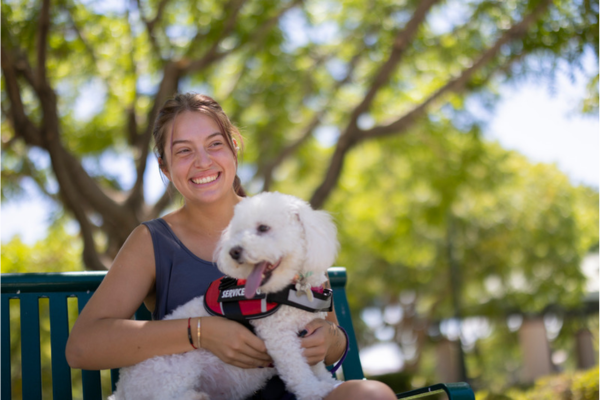A service dog is more than a pet. They serve as valuable companions in many people’s lives because service dogs help differently abled people live independently and access assistance in emergencies.
Unfortunately, many people don’t understand service dogs. Myths and stereotypes guide reactions and cause some people to act disrespectfully in the presence of these dogs and their owners. This article will debunk common myths and stereotypes and raise service dog awareness.
Common Stereotypes About Service Dogs
Misconception 1: Service dogs are only for the blind
Many people think service dogs only serve blind people. However, they can assist individuals with various disabilities such as epilepsy, mobility issues, hearing impairments, mental disorders, diabetes, and musculoskeletal conditions.
Misconception 2: Service dogs are pets, not working animals
A service dog is not an ordinary pet and should not be treated like one. If you are in the presence of a service dog, you should never touch it without asking the owner’s permission. You should never feed it and keep your distance from it in general. Any interference may prevent the dog from serving its owner.
Misconception 3: Any dog can be a service dog
Not every dog can be a service dog. Service dogs must undergo extensive training to provide the necessary care for their handlers. You cannot choose a service dog randomly and decide it will be a service dog.
Misconception 4: Service dogs are always large breeds
When people think of service dogs, they often think of large breeds. However, small breeds can also provide service, and they are preferred by many for various reasons. Smaller dogs tend to have easygoing temperaments, ideal for people with emotional issues. They are also low maintenance, easy to travel with, and less expensive than their larger counterparts.
Misconception 5: Service dogs are not needed for invisible disabilities
Some people may see a person with no apparent disability with a service dog and think they don’t require the assistance. However, service dogs can assist with several ‘invisible disabilities.’ These include emotional disorders, hearing impairment, and some mobility issues.
The Reality of Service Dogs
The varied roles of service dogs beyond assisting the visually impaired
Service dogs do a lot more than assist the visually impaired. They can assist people with vertigo and mobility issues so they maintain stability and balance. They can pull wheelchairs. Service dogs can also help disabled people by alerting others, assisting during emergencies, and bringing items to their handlers.
Training and certification requirements for service dogs
Service dogs must undergo specific training following the needs of the disability they are trained to handle. Although no training standard exists, most experts recommend that service dogs undergo 120 hours of training over six months. Service dogs may also be subject to a public access test, ensuring they can behave publicly.
A handler is not required to carry any certification or documentation for their service dog. However, some establishments may want to see Service Dog status. It can also help ensure that the service dog and handler are treated respectfully. Many handlers carry a Service Dog ID card or vest for these purposes.
The diversity of breeds used as service dogs
Certain dog breeds tend to make the best service dogs. However, any breed can be a service dog, provided it has the temperament for the job.
How service dogs assist individuals with invisible disabilities
Service dogs go beyond helping people with visible disabilities. They may assist with invisible disabilities in the following capacities:
- Diabetes: Service dogs can be trained to smell the compounds released when their handler’s blood sugar is high or low. They can alert their handlers to seek treatment to prevent them from becoming symptomatic.
- PTSD: A service dog can recognize when a handler with PTSD is experiencing anxiety. They can offer comfort by initiating physical contact with their handler. They can also serve as a physical barrier between their handler and other people to reduce anxiety and wake their owner from nightmares.
- Epilepsy: Service dogs can stay with epileptic handlers throughout a seizure. They can also fetch medications or alert a caretaker if a seizure is imminent.
Impact of Stereotypes on Handlers
Handlers face several challenges due to stereotypes. For example, people who think the dog is a pet may play with them and interrupt them from their duty. People often assume that since handlers aren’t visually impaired, they don’t require a service dog. Another common stereotype occurs when people don’t take a small service dog seriously.
They may also not understand service dog laws and block handlers and their dogs from entering public spaces.
Service dogs and their handlers should be permitted in most businesses and public spaces. Legal action may be taken by handlers who are refused entry. Depending on the nature of the discrimination, you can file a complaint with the Department of Justice, the Department of Transportation, and your local housing and employment offices. You may also file a lawsuit in federal, state, or small claims court.
Handlers have recourse in the face of discrimination, but that doesn’t erase the emotional and psychological effects. Handlers and their dogs should feel welcome in businesses and public spaces, and the public should celebrate their ability to live an independent lifestyle.
Discrimination makes handlers feel uncomfortable entering public spaces with their dogs, which can make them feel more disadvantaged by their disability. Service dog awareness can change negative attitudes and make handlers feel more accepted.
Educating the Public
The plight of service dog handlers is real, but there are solutions. Organizations and individuals can spread service dog awareness and educate the public about service dogs, their uses, and their rights.
Fortunately, several advocacy groups speak up for service dogs and their handlers. Justice Speaks is the perfect example.
Justice Speaks trains school-age kids on the appropriate way to act around service dogs and their handlers. We also go into workplaces and train employees on compliance. Our main goal is to provide resources to the community so they can learn more about dog handler rights.
Individuals can also do their part. Examples include sharing accurate information about service dog rights on social media, showing respectful behavior to service dogs and their handlers, and encouraging others to do the same.
Real-Life Stories
Several dog handlers have had unpleasant experiences in public spaces, but many found resolutions that positively impacted their lives. Here are some examples.
Bethann Siviter
Bethann Siviter took to Quora to discuss a situation in which she and her service dog were asked to leave a restaurant even though they had already paid for their meal. Although they stayed in the restaurant, they were harassed by staff.
She followed up with an ‘intention to litigate.’ The manager responded and said he would not comply. He encouraged her to “go ahead and sue.”
However, after speaking to a litigator, Bethann got a response from the business owner. Upon her request, he agreed to pay her $250 and donate another $250 to a service dog charity.
He fired the manager, began an employee training program, and put up signs saying service dogs were welcome. He also invited Bethann in for another meal.
“We had a lovely meal; he came to meet my dog and thanked me for giving him a chance to improve his business,” Bethann said.
Nancy Sommers
Nancy Sommers had a similar experience when she was told to leave a swimming pool area. She was a guest of her daughter, but one of the residents was not happy that her dog was accompanying her. She also noted that he “was disgruntled that my toddler grandson also came in and was rude and bullied him as well.”
Sommers took the man to court on principle and had a satisfying resolution. “We received a sincere and honest apology in front of a judge. And even more important, we felt a genuine BULLY discovered a part of his heart that had been sealed long ago.”
Conclusion
Service dogs help disabled people enjoy an independent lifestyle, but stereotypes can interfere with the handler’s ability to feel comfortable in public spaces. People must understand how to treat service dogs and the disabilities they serve. They should realize that service dogs can be of all breeds, shapes, and sizes.
You can help by educating yourself and others. Use social media and share this blog to spread service dog awareness. Partner or donate to organizations like Justice Speaks to do your part.
Resources for further reading and support
- ADA.gov: Explore this page of the Americans with Disabilities Act website to learn various service animal laws.
- Find Law: This web page offers a complete guide to service animal laws, rights, and resources.
- U.S. Service Animals: This site allows you to register your service animal or apply for a letter from a licensed health professional requesting housing.
Links to Justice Speaks’ resources and support networks
- School-Aged Education: Learn about our training course, curriculum, and certificates.
- Workplace Compliance: Discover what it takes to get your business workforce compliant.
- Advocacy: Learn more about your rights as a service dog handler and how you can promote legislative changes.
- News: Find out how we are making a difference.
Blog: Read our blog to familiarize yourself with service dog ownership and compliance aspects.


